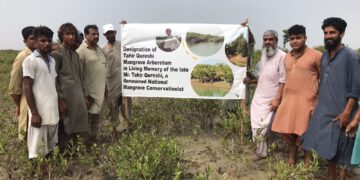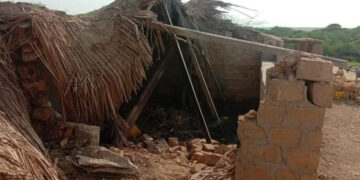 Will there, or won’t there be floods this year? Amid a sense of foreboding stemming from past failure to meet the eventuality, there is also the spectre of drought in some areas…
Will there, or won’t there be floods this year? Amid a sense of foreboding stemming from past failure to meet the eventuality, there is also the spectre of drought in some areas…
In an agrarian country like Pakistan, the advent of monsoons has been associated with hope, happiness and festivity. This is the time when farmers hope to reap the rewards of their hard work. They wait for monsoons to give life to their crops, and plan to use the earnings for things that require big spends, like marriage in the family, house repairs, buying livestock, tractor or a vehicle. All of this comes to nought if the monsoon does not bring enough rain, or brings too much rain, or comes at the ‘wrong’ time. Now, there may be Climate Change nay sayers elsewhere in the world, but you will not find many in Pakistan because here, it is not something that is going to happen, it is happening already! The shifting pattern of monsoon and its increasing ferocity has played havoc in more ways than one. To get the context right, we must keep in mind that 75% of the rainfall that Pakistan receives is dependent upon the monsoons. While it is debatable whether the devastation Pakistan witnessed in the wake of the 2010 floods was due to Climate Change or man-made factors of massive deforestation of the forests in Khyber-Pakhtunkhwa and encroachments in the river beds, one must be mindful of the fact that the amount of rainfall received was unprecedented.
This was again the cause of the devastation suffered by Sindh in 2011, when a cloud burst sent down more rain than could be handled by the channels and drains which overflew their banks. That, too, of course, was a disaster compounded by manmade factors of poor maintenance of the water courses, and bad planning of drains, especially the infamous LBOD, the Left Bank Outfall Drain, which allowed the back flow of sea water at the Tidal Link with the sea. The country is still grappling with the aftereffects of those two back-to-back disasters. There are still people living in temporary shelters in most parts of Sindh. Those who had been able to rehabilitate their homes and lands, are now apprehensive of what the coming monsoon may bring them.
Late June to September is usually the time when everyone looks skywards hoping for the clouds to bring rain. City dwellers have more reasons to fear them for reasons of poor urban planning and infrastructure maintenance. However, the farmers in Pakistan have already faced the brunt of a pre-monsoon, when sudden, and heavy rainfall accompanied by hail in March laid to waste vast tracts of standing crop and killed livestock in many parts of Punjab. This change in timing of the pre-monsoon and its ferocity in itself is a disaster that is not yet been accounted for. But are we also ready for an impending disaster in the wake of the monsoon in 2012?
Is there likely to be another mega flood? Have the institutions and departments learnt from the past shortcomings and taken preemptive measures? The million, or actually the billion dollar question is, will there or won’t there be another flood come monsoon? Dharki area of Sindh had been hit by floods in 2010. A senior district official there has already been instructed to take measures. He said, “Contingency plans have been updated. Multi-agency coordination has been strengthened. Commissioners of divisions have conducted meetings with Army High Command regarding preparatory measures. List of volunteers have been provided at Taluka levels. Army personnel have visited the vulnerable areas and government machinery to be used in case of emergency.
He added, “Management plans have been prepared. Guidelines have been obtained from the National Disaster Management Authority (NDMA) and its provincial chapter (PDMA). These authorities have started provision of some relief goods like temporary shelters to vulnerable districts i.e. Badin, Thatta etc. “As far as relief and rehabilitation is concerned, the government has almost completed the financial aid through Watan Card to last year’s flood victims. Moreover, NDMA and PDMA in liaison with international organizations are stocking food and non-food items.” While this is heartening to know, similar preparations had been ordered after the 2010 floods but still most districts, where the administration was not up to speed, suffered from a total breakdown of the system. Barring a couple of districts like Thatta and Badin, it was the civil society and INGOs who had to step in — and in a big way for assistance.
What has changed from the last two years that can bring in a level of comfort? The main reason, deforestation in Khyber-Pakhtunkhwa is still there so any rain there will run off downstream, taking with it whatever precious little soil cover that is there. Has a de-silting of the water channels been done? Have the dykes been strengthened? And who will be the watchdog over the breaches and cuts given by the powerful landlords who divert water from their lands on to the other, less powerful farmers? Has the design fault of LBOD been rectified? Have old water channels and dry river beds been rehabilitated so excess water can be diverted towards them or towards the desert areas to make artificial wetlands? All of the above questions require an answer in the context of a possibility of another flood. But are we expecting another one or is the NDMA drumming up panic without substantive reason. Is flood the only disaster Pakistan has to be mindful of?
If you look at the map of the forecast (http://www.pmd.gov.pk/forecast/3monthForecast.pdf) drawn up by the Pakistan Meteorological Department, you will see that there is another disaster that Pakistan may be facing — not of too much rain but of too little rain! At least in the breadbasket region of the country. Less than normal rainfall means less water in the rivers, and not just less water for irrigation, but less for electricity generation. Aside from the war-on-terror and political instability, issues of food and energy security are the ones that greatly impact the functioning of the country. Has a disaster management plan even been thought of in case of severe drought and food shortages and a worsening energy crisis? How will the turmoil they are going to result in be dealt with? The migration of population even within Pakistan has a huge socio-economic, as well as political impact, and the poverty-crime nexus only becomes stronger in the absence of any safeguards against weather induced uncertainties.
Met department warnings about more than normal rainfall in Khyber Pakhtunkhwa, drought like conditions in the central and southern plains, and the shift of the monsoons to the Southwest, bringing a possibility of more than normal rainfall in the coastal belt of Sindh mean that a holistic response needs to be devised. We need to be prepared for floods in areas where there will be more than normal rainfall, but we need to have a visible strategy to combat effects of drought as well. Floods in our case may not just be a lot of water in the rivers and canals. If not adequately planned for, they could mean a flood of problems to contend with, which can be very destabilizing economically, as well as socially.
This article was originally published on PIQUE.












